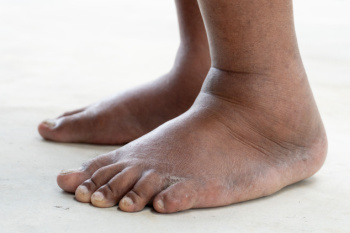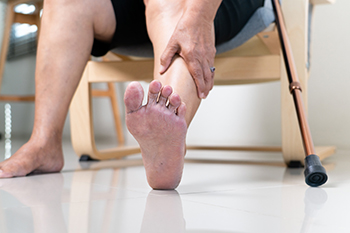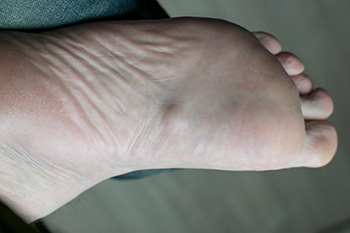
Swollen feet, a condition known as edema, is common among people with diabetes. Edema occurs when fluid builds up in the tissues, leading to puffiness, especially in the feet, ankles, and legs. Diabetes can contribute to edema due to poor circulation, nerve damage, or kidney problems, all of which make it harder for the body to regulate fluid properly. Symptoms of swollen feet include visible puffiness, tight or shiny skin, and discomfort. If left untreated, swelling can lead to complications, including infections or ulcers, especially in diabetic patients with reduced sensation in their feet. Treatment for edema typically involves elevating the feet, wearing compression socks, managing blood sugar levels, and limiting salt intake. In some cases, a podiatrist may recommend specific exercises or custom footwear to alleviate pressure. If you are experiencing swollen feet, it is suggested you schedule an appointment to see a podiatrist. Early intervention can prevent further complications and provide effective relief.
Swollen feet can be a sign of an underlying condition. If you have any concerns, contact one of our podiatrists of Jill Einhorn, DPM and James Einhorn, DPM. Our doctors can provide the care you need to keep you pain-free and on your feet.
Swollen feet are a common ailment among pregnant women and people who stand or sit for extended periods. Aging may increase the possibility of swollen feet and patients who are obese often notice when their feet are swelling too. There may be medical reasons why swollen feet occur:
Swollen feet can also be caused by bone and tendon conditions, including fractures, arthritis, and tendinitis. Additionally, there may be skin and toenail conditions and an infection may cause the feet to swell. Patients who take medicine to treat high blood pressure may be prone to getting swollen feet.
Many patients elevate their feet to help relieve the swelling and this is generally a temporary remedy. When a podiatrist is consulted the reason behind the swelling can be uncovered and subsequently treated.
If you have any questions please feel free to contact our offices located in Brooklyn and Astoria, NY . We offer the newest diagnostic tools and technology to treat your foot and ankle needs.

Foot stress fractures are small cracks in the bones of the foot, often resulting from repetitive stress or overuse. Common causes include high-impact activities, sudden increases in exercise intensity, and inadequate footwear. Symptoms typically include localized tenderness, pain, and weakness in the affected area, especially during physical activity or when putting weight on the foot. Swelling and bruising may also occur. Treatment for stress fractures focuses on rest and immobilization. A podiatrist may recommend using a walking boot or crutches to reduce pressure on the foot, along with anti-inflammatory medications to alleviate pain. Gradual rehabilitation exercises can also help restore strength and flexibility. If you suspect you have a foot stress fracture, it is suggested that you consult a podiatrist. They can provide an accurate diagnosis and develop a tailored treatment plan to promote healing and prevent future injuries.
Stress fractures occur when there is a tiny crack within a bone. To learn more, contact one of our podiatrists from Jill Einhorn, DPM and James Einhorn, DPM. Our doctors can provide the care you need to keep you pain free and on your feet.
How Are They Caused?
Stress fractures are the result of repetitive force being placed on the bone. Since the lower leg and feet often carry most of the body’s weight, stress fractures are likely to occur in these areas. If you rush into a new exercise, you are more likely to develop a stress fracture since you are starting too much, too soon. Pain resulting from stress fractures may go unnoticed at first, however it may start to worsen over time.
Risk Factors
Stress fractures do not always heal properly, so it is important that you seek help from a podiatrist if you suspect you may have one. Ignoring your stress fracture may cause it to worsen, and you may develop chronic pain as well as additional fractures.
If you have any questions, please feel free to contact our offices located in Brooklyn and Astoria, NY . We offer the newest diagnostic and treatment technologies for all your foot care needs.

In older adults, foot and ankle pain is common. Pain originating in the feet often includes arthritis, bunions, and plantar fasciitis, which develop due to joint wear, inflammation, or tissue strain. Conversely, pain can also start outside the feet from nerve compression in the spine or hip arthritis, which can radiate down to the feet and cause discomfort. Aging naturally changes foot structure. Fat pads on the soles are thin, making feet more vulnerable to pressure, skin becomes drier and less elastic, and ligaments may stretch, causing flat feet or instability. Treatment often includes supportive, well-fitted shoes and custom orthotics to reduce strain. In more severe cases, injections, like corticosteroids, reduce inflammation. Surgery may be necessary to correct structural issues or relieve persistent pain. If you are elderly and experience foot or ankle pain, it is suggested that you schedule an appointment with a podiatrist for a proper diagnosis and treatment.
Proper foot care is something many older adults forget to consider. If you have any concerns about your feet and ankles, contact one of our podiatrists from Jill Einhorn, DPM and James Einhorn, DPM. Our doctors can provide the care you need to keep you pain-free and on your feet.
The Elderly and Their Feet
As we age we start to notice many changes in our body, but the elder population may not notice them right away. Medical conditions may prevent the elderly to take notice of their foot health right away. Poor vision is a lead contributor to not taking action for the elderly.
Common Conditions
Susceptible Infections
Diabetes and poor circulation can cause general loss of sensitivity over the years, turning a simple cut into a serious issue.
If you have any questions please feel free to contact our offices located in Brooklyn and Astoria, NY . We offer the newest diagnostic and treatment technologies for all your foot and ankle needs.

A plantar fibroma is a benign tumor that develops in the plantar fascia, the thick band of tissue running along the bottom of the foot. Typically found in the arch, it appears as a firm lump that may cause discomfort during walking or standing. Diagnosing a plantar fibroma involves a thorough medical history and physical examination, where a podiatrist will assess the lump's size, location, and texture. Imaging studies such as ultrasound or MRI scans may be employed to confirm the diagnosis and rule out other conditions. The exact causes of plantar fibromas remain unclear, though factors such as genetics, trauma, and certain medical conditions may contribute to their development. Having a plantar fibroma can be uncomfortable. If you have developed this condition, it is suggested that you consult a podiatrist who can offer you relief options.
A plantar fibroma may disrupt your daily activities. If you have any concerns, contact one of our podiatrists of Jill Einhorn, DPM and James Einhorn, DPM. Our doctors can provide the care you need to keep you pain-free and on your feet.
Plantar Fibroma
A plantar fibroma is a fibrous knot in the arch of the foot. It is embedded in the plantar fascia which is a band of tissue that extends from the heel to the toes along the bottom of the foot. There can be multiple plantar fibromas in the feet at the same time. There are no known causes for this condition. If you have a plantar fibroma, there will be a bump in the arch of your foot that cannot be missed. Any associated pain is most often due to a shoe rubbing against the nodule. Non-surgical options, such as steroid injections, physical therapy, and orthotics should be tried first. Surgery is a last resort and is the only thing that will remove a plantar fibroma entirely. Consult with a podiatrist for a proper diagnosis and to determine the treatment regimen that is right for you.
What Causes a Plantar Fibroma?
While there are no specific causes identified, a plantar fibroma can possibly come from genetic predisposition or the formation of scar tissue that forms from healing the tears in the plantar fascia.
What Are the Symptoms of a Plantar Fibroma?
There will be a noticeable lump in the arch of the foot that may or may not cause pain. If pain is felt, it is typically because a shoe is rubbing up against the lump or when walking or standing barefoot.
Treatment and Prevention
A plantar fibroma will not disappear without treatment, but it can get smaller and be a non-issue. If pain persists, a podiatrist examines the foot and when the arch of the foot is pressed, pain can be felt down to the toes. An MRI or biopsy might be performed to help diagnose or evaluate the plantar fibroma. The following non-surgical options are generally enough to reduce the size and pain of these nodules:
Surgery is considered if the mass increases in size and the patient continues to feel pain after non-surgical methods are tried.
If you have any questions please feel free to contact our offices located in Brooklyn and Astoria, NY . We offer the newest diagnostic tools and technology to treat your foot and ankle needs.